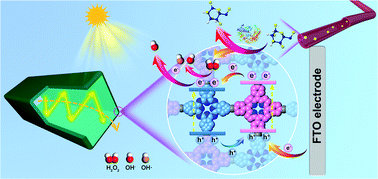A high-performance photoelectrochemical sensor for the specific detection of H2O2 and glucose based on an organic conjugated microporous polymer†
Abstract
Cathodic photoelectrochemical (PEC) biosensors are one of ideal systems for sensing applications owing to their advantages in the low-cost, simplicity of the detection and miniaturization of the sensors with high sensitivity and specificity. Herein, a high-performance PEC sensor based on a 2D porphyrin–phthalocyanine conjugated microporous polymer (PorPc-CMP) is reported for the specific detection of H2O2 and glucose in the wide linear ranges of 0.05–100 and 0.05–5000 μM with an ultra-low limit of detection (LOD) of 13 and 27 nM, respectively. All of them achieved the best levels, when compared to H2O2 and glucose tetrapyrrole-based photoelectrochemical sensors reported so far. After a comparative analysis on the morphology, optical–electrical properties and partial charge density plots by DFT calculations for the PorPc-CMP and its analogues (PorPor-CMP and PcPc-CMP), it is revealed that the high PEC-sensing performance of PorPc-CMP is largely related to the synergistic effect of unique multi-channel D–A structure and elaborate hollow tube-like morphology, which leads to the effective charge separation, enhanced charge transportability and high utilization of light irradiation. Furthermore, good accuracy of the PorPc-CMP PEC sensor was demonstrated in real sample analysis of H2O2 disinfectant and human serum samples.



 Please wait while we load your content...
Please wait while we load your content...